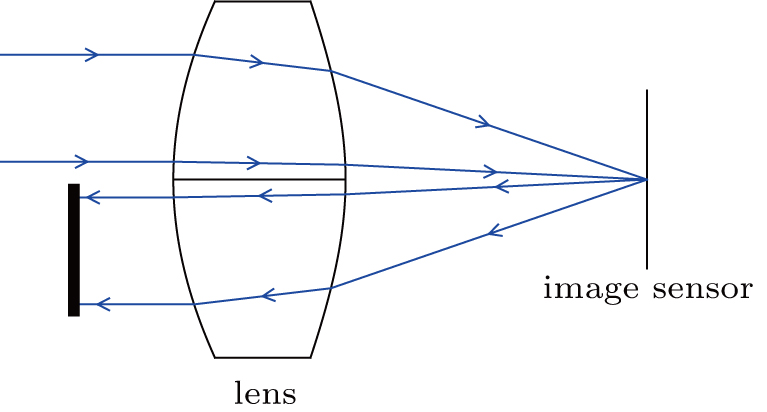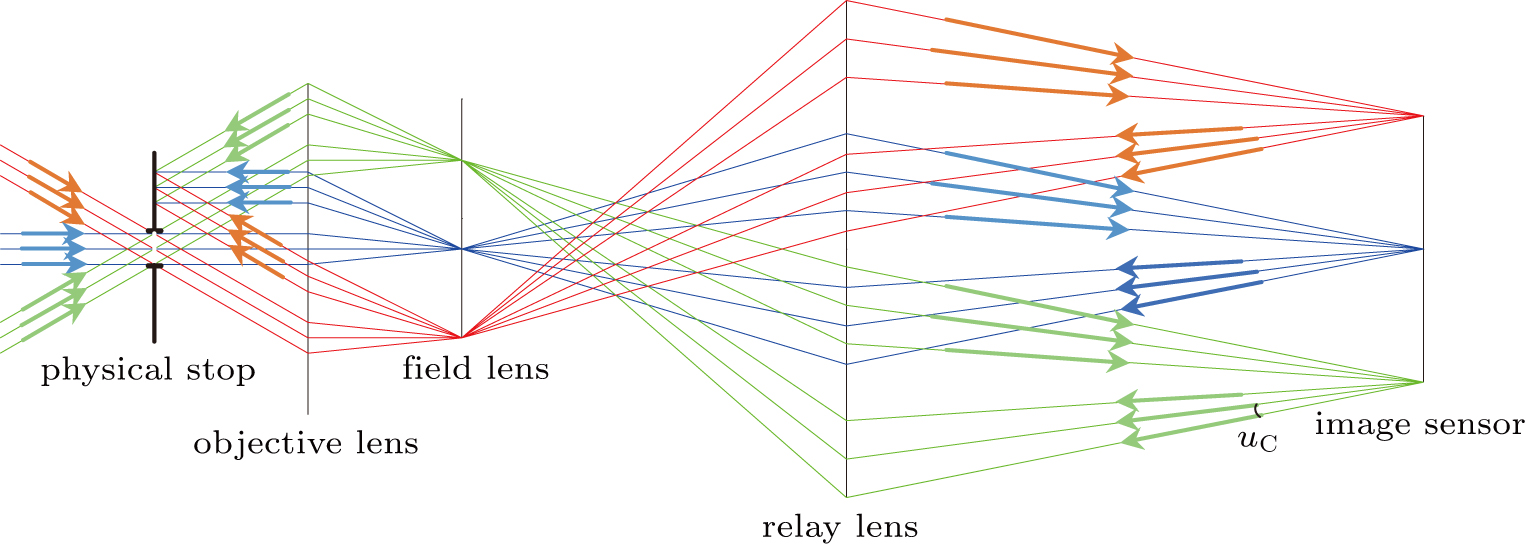Project supported by the National Natural Science Foundation of China (Grant No. 61471039).
Project supported by the National Natural Science Foundation of China (Grant No. 61471039).
† Corresponding author. E-mail:
Project supported by the National Natural Science Foundation of China (Grant No. 61471039).
Optoelectronic imaging equipment is easy to expose to active laser detection devices because of “cat eye” effect. In this paper, we propose a new structure of optical system to reduce the retroreflector effect of a cat eye target. Decentered field lens structure is adopted in the design without sacrificing imaging quality and clear aperture. An imaging system with ±30° field of view is taken for example. The detailed design and simulation results are presented. The results indicate that this kind of optical system can reduce the retroreflection signal substantially and maintain acceptable imaging performance.
Because of strong ability and high precision in detecting and capturing target images, the scouting, tracing, and measuring devices based on optoelectronic imaging are widely used. However, “cat eye” effect exists in most of imaging devices, leading to the retroreflection of incident light energy.[1,2] It is shown that the retroreflected light power is several times stronger than the power of diffusion target around. This cat eye effect is employed to scan, detect, and recognize an optoelectronic imaging equipment by the active laser detection technology.[3–5] The active laser detection devices are widely used in manportable, mobile, and onboard optoelectronic warning systems and possess good performance, and thus increasingly challenging the traditional optoelectronic imaging equipments.[6–13]
Some methods are proposed to reduce the retroreflection signal and cut down the effective range and identification probability of an active laser detection device. Defocusing method[14] can change the position of intersection point of reflected rays which are hence blocked by the lens diaphragm partly. But it will influence the imaging quality on the image sensor because of the departure from the optimal focus position. Camera tilting method can change the exit direction of the retroreflection rays and reduce the strength of reflected light to a certain extent. The more slanted the camera, the more the reflected energy that could be obscured. However, the seriously tilted image plane will induce large aberrations and also sacrifice the imaging quality. Another method is to use the band stop optical filter which will absorb the incident probe beam energy.[15] This method will not affect the imaging performance, but it can affect certain specific wavelengths only. An active laser detection device based on the wavelength tunable laser will abandon this method. An alternative way is to obscure part of the aperture stop.[16] The incident light entering the clear aperture will be blocked by the obscured part when it is retroreflected, hence no echo wave energy can be detected theoretically. Although this method has the potential to eliminate the cat eye effect completely, it reduces at least half of the pupil aperture in fact and affects the illuminance of image plane and diffraction limit of imaging lens. The above methods can reduce the cat eye effect of optoelectronic imaging system to an extent; however, they have limitations when put into practice.
Therefore, it is necessary to work out an improved scheme that has few influences on imaging performance but has an effect on more active laser detection device. In the present paper, we propose an ordinary and effective geometrical method in which a decentered field lens structure is adopted for reducing the retroreflection effect, and an example imaging system maintaining acceptable image quality is proposed. The simulation results are also shown subsequently.
An ideal cat eye effect model can be equivalent to a combination of an imaging lens and a reflecting surface located on the focal plane[17] as shown in Fig.
 | Fig. 1. (color online) Cat eye effect equivalent model layout including imaging lens and reflecting mirror. |
The laser echo power received by the receiving system detector can be described as[18]
 |
If there exists a scheme in which the incident ray falling on the reflecting plane could be reflected by a completely different route, it will be able to find a way to block the reflected beam in an appropriate manner. A feasible way is to change the incident angle on the reflecting plane. As all the rays in an incident beam hit the reflecting plane on one side of optic axis as shown in Fig.
 | Fig. 2. (color online) Rays incident on one side of optic axis, thus reflected rays can be blokcked. |
Considering that the field lens is commonly placed at or near the focal plane, the effect of the lens is to change the ray angle at the image plane, and hence reducing the clear aperture of the lens group behind usually. If placed exactly at the focus, it has little effect on the power and aberrations of the objective.
As shown in Fig.
 |
If the field lens is decentered in the direction perpendicular to the axis, the deflection angle of the chief ray of each field of view will change a certain amount. Figure
For the field lens, the matrix notation can be described as[19]
 |
 |
For the relay lens, the matrix notation can be described as[19]
 |
 |
 |
The accomplished system layout (as shown in Fig.
 | Fig. 8. (color online) Plots of modulation transfer function vs. field of view (direction of field lens decenter) with (a) decentered field lens and (b) coaxial field lens. |
| Table 1.
Relevant specifications for designing anti-detection imaging optical system. . |
| Table 2.
RMS spot radius vs. field of view (direction of field lens decenter) with decentered field lens and coaxial field lens. . |
Next, the commercial optical illumination modeling software is used to simulate the detection procedure, and the results are shown in Fig.
Figure
We analyze and show the design of an anti-detection optical imaging system with field lens decentering scheme. The decentered field lens is an effective and practical way to reduce the cat eye effect. The value of modulation transfer function is greater than 0.2 at 50 cyc/mm across more than 70% of central field of view, and the average values of RMS spot radius for 7 fields of view before and after decentering the field lens are 6.632 μm and 7.054 μm, respectively. It indicates that the integral imaging quality degradation is little compared with the coaxial lens, and the field lens decentering scheme maintains acceptable imaging performance.
| [1] | |
| [2] | |
| [3] | |
| [4] | |
| [5] | |
| [6] | |
| [7] | |
| [8] | |
| [9] | |
| [10] | |
| [11] | |
| [12] | |
| [13] | |
| [14] | |
| [15] | |
| [16] | |
| [17] | |
| [18] | |
| [19] |








